-
Artigo Original09/06/2025
Epidemiological profile of breast cancer in a reference center in the north region of Brazil
Revista Brasileira de Ginecologia e Obstetrícia. 2025;47:e-rbgo27
Resumo
Artigo OriginalEpidemiological profile of breast cancer in a reference center in the north region of Brazil
Revista Brasileira de Ginecologia e Obstetrícia. 2025;47:e-rbgo27
Visualizações111Ver maisAbstract
Objective:
To describe the epidemiological data of women with breast cancer at a referral center in oncology in the northern region of Brazil.
Methods:
This is a retrospective cohort study. The study population consists of patients who were diagnosed with in situ or invasive BC (invasive carcinoma of no special type (ICNST) and invasive lobular carcinoma (ILC)) at the Hospital de Amor da Amazônia, in Porto Velho – Rondônia, between January 2012 and December 2021. The sampling plan adopted was of the convenience type. All patients who received the anatomopathological diagnosis of in situ or invasive BC at the Hospital de Amor da Amazônia from 2012 to 2021 and came from the North region were included. Exclusion criteria were non-origin from the North region and absence of diagnosis established by anatomopathological examination of breast cancer. Analysis of the database and medical records of the Hospital de Amor da Amazônia was carried out to collect information.
Results:
420 patients were included, 99.5% female, with complete elementary school (32,6%) and brown skin (68,1%). The mean age at diagnosis was 49 years. Forty-five percent were born in the northern region and 55% in other regions of Brazil. Eighty percent of tumors were invasive ductal carcinoma; 32.7% were luminal A-like, 25.1% luminal B-like, 19.4% HER2 enriched and 12.8% triple negative. When patients were subdivided by age ≤40 years and > 40 years, there was a statistically significant difference in the association with staging (p=0.000), histological type (p= 0.035), immunohistochemistry subtype (p=0.000), neoadjuvant chemotherapy (p=.000) and genetic counseling (p=0.001). The median survival was 7.99 years. The 5-year overall survival was 81%. The higher the stage, the lower the survival rate. Twenty-four distinct variants were described in patients undergoing genetic testing, 16 of uncertain significance and 8 pathogenic. Three new variants were described: ATM (c.8726G>C), BRCA2 (c.2232A>C) and ERCC5 (c.2164G>Ap).
Conclusion:
In this study, the age at diagnosis of breast cancer was lower, the tumor subtype was more aggressive, and patients were admitted in more advanced stages. Overall survival is lower compared to national and international data. Despite the small number of patients referred to genetic testing, it is important to search for germline mutations to improve patients’ diagnosis and treatment.
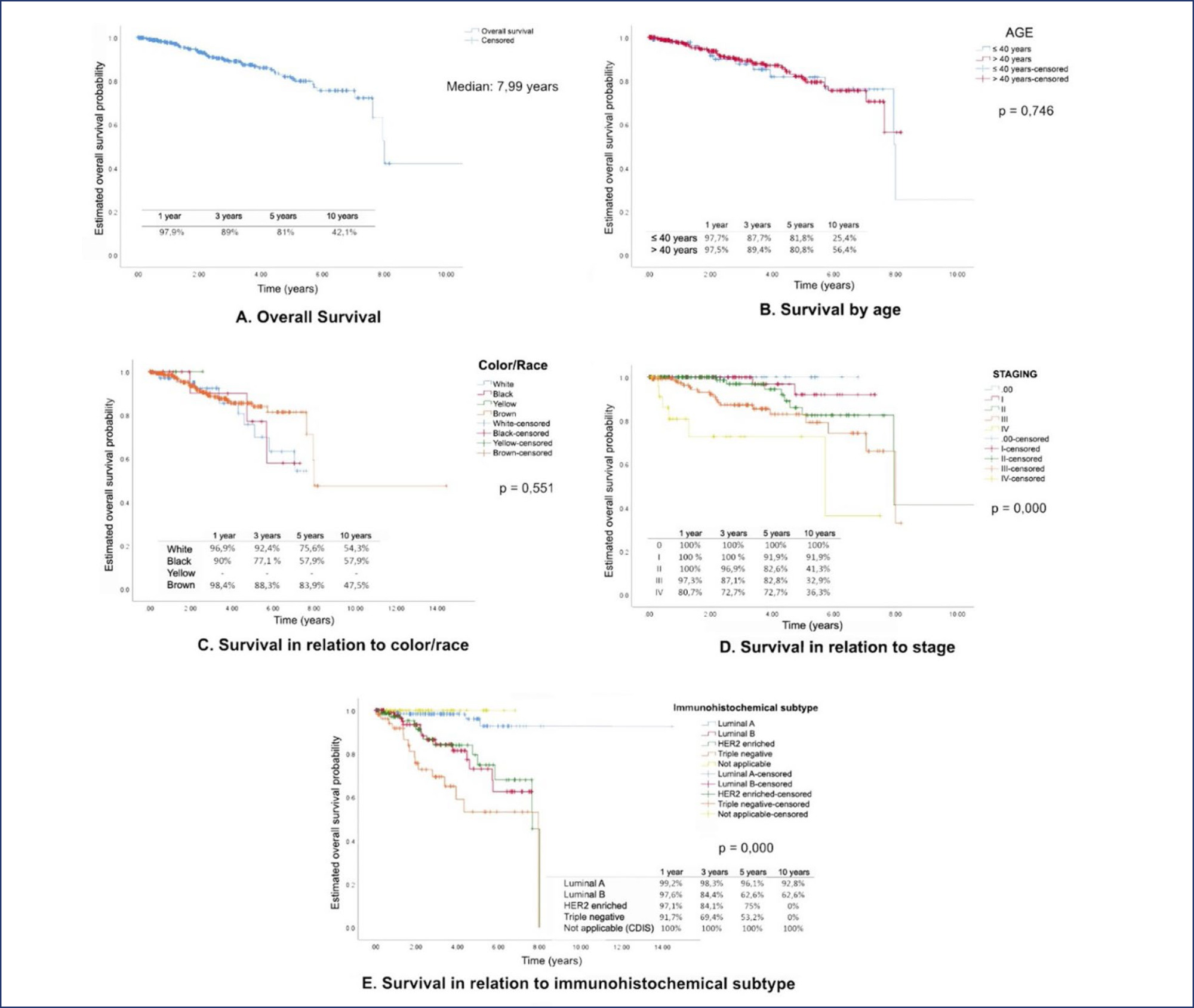
-
Artigo Original09/06/2025
Evaluation of chronic radiation proctitis in patients with cervical cancer treated with pelvic radiotherapy: a cross-sectional study
Revista Brasileira de Ginecologia e Obstetrícia. 2025;47:e-rbgo26
Resumo
Artigo OriginalEvaluation of chronic radiation proctitis in patients with cervical cancer treated with pelvic radiotherapy: a cross-sectional study
Revista Brasileira de Ginecologia e Obstetrícia. 2025;47:e-rbgo26
Visualizações93Ver maisAbstract
Objective:
A combination of chemotherapy and pelvic radiotherapy is recommended to treat locally advanced cervical cancer (CC), which has been associated with acute and chronic toxicities, especially radiation proctitis (RP). The objective of this study was to evaluate the frequency of RP and treatment management in females with CC who underwent pelvic radiotherapy at an oncology referral hospital.
Methods:
This cross-sectional study analyzed the medical records of patients treated with radiotherapy for CC between 2015–2017. We assessed sociodemographic, lifestyle, cancer, treatment, and clinical variables. We identified 298 records of females with CC who underwent pelvic radiotherapy during the defined period. Of these, 14 records were duplicates, 25 were excluded for lacking essential information, and 33 were missing in the archive. Accordingly, 226 relevant medical records were analyzed, with data regarding sociodemographic, clinical, cancer-related, treatment-related, and RP-related variables collected. Pearson’s chi-square test was used to compare symptomatic and non-symptomatic patients. Fisher’s exact test was used to compare chemotherapy doses. Statistical analysis was performed with Stata V12.1. A P-value less than 0.05 was considered significant.
Results:
The median patient age was 48 years (interquartile range 38–61). Patients predominantly had CC stages IIB and IIIB (>70%). Of the 226 females analyzed, 87(38.5%) experienced RP symptoms, represented by rectal bleeding; of these, 59 underwent colonoscopy, confirming RP in 58(98.3%). Accordingly, of the 226 females analyzed, 58(25.7%) had a confirmed diagnosis of RP. There was a statistically significant association between rectal bleeding and cumulative radiation dose (P < 0.001) and the presence of systemic arterial hypertension (P = 0.036). Regarding treatment, 38(65.5%) participants underwent argon plasma coagulation (APC), and of these, 22(57.9%) had no post-treatment macroscopic bleeding.
Conclusion:
Patients with CC who received radiotherapy at an oncology referral service had a high frequency of RP, and APC helped control bleeding in certain patients.
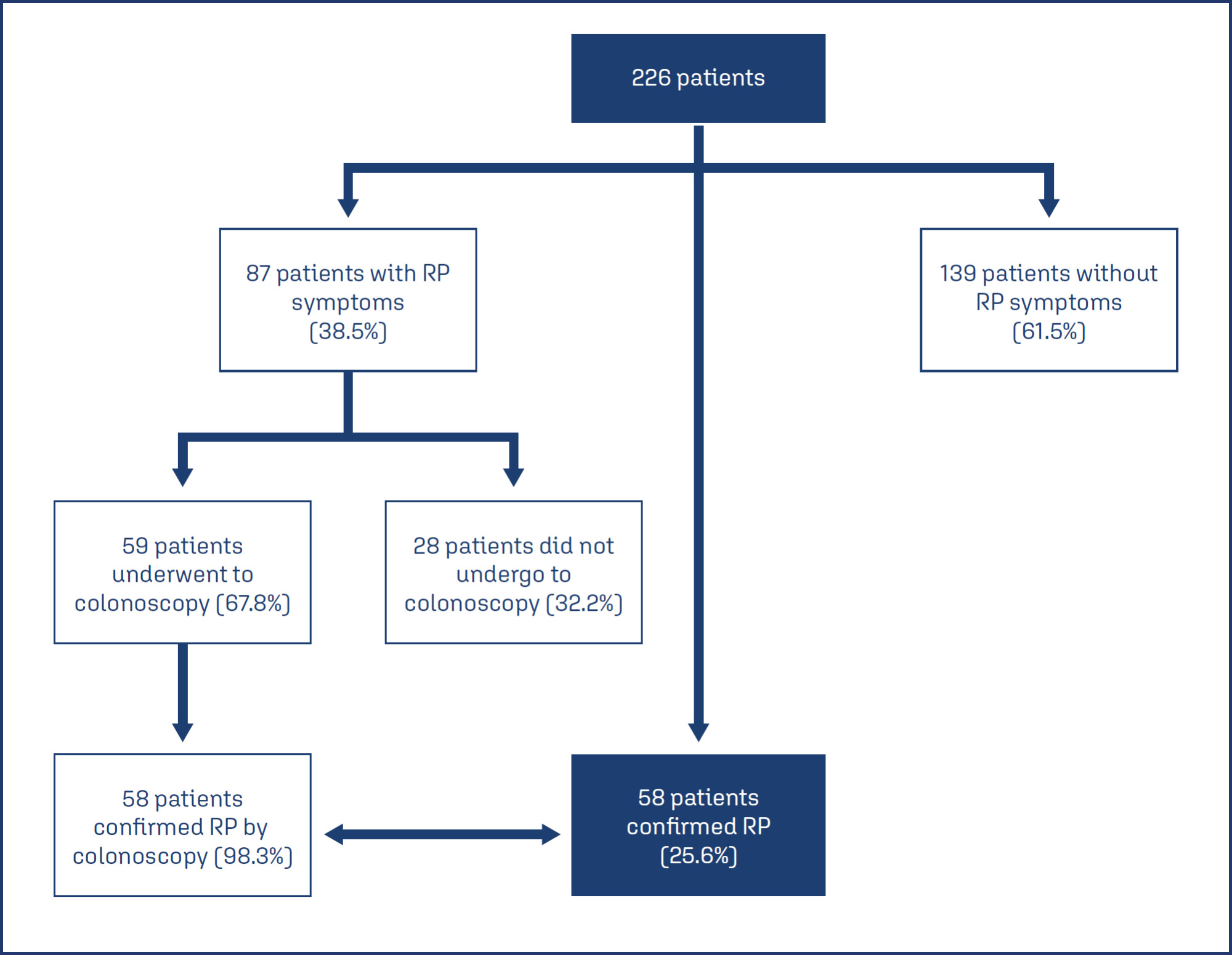
-
Artigo Original09/06/2025
Impact of the Zero Maternal Death by Hemorrhage Strategy on health professionals’ self-perceived knowledge in managing postpartum hemorrhage
Revista Brasileira de Ginecologia e Obstetrícia. 2025;47:e-rbgo25
Resumo
Artigo OriginalImpact of the Zero Maternal Death by Hemorrhage Strategy on health professionals’ self-perceived knowledge in managing postpartum hemorrhage
Revista Brasileira de Ginecologia e Obstetrícia. 2025;47:e-rbgo25
Visualizações94Abstract
Objective:
This study aimed to evaluate the results of the Obstetric Hemorrhage Prevention and Management Course – Zero Maternal Death by Hemorrhage Strategy (0MMxH) among healthcare professionals before and after participation.
Methods:
A quasi-experimental design was employed, assessing the educational intervention in a convenience sample of healthcare professionals who had participated in the 0MMxH at least one year prior. Participants completed a retrospective pre-post questionnaire sent via email, focusing on self-perceived knowledge levels and the adoption of best practices in postpartum hemorrhage (PPH) management.
Results:
Out of 129 professionals who completed the 0MMxH training, 85 (65.9%) responded to the questionnaire. The percentages of respondents reporting no or low knowledge before and after the course were: shock index (52.8% to 0%, before and after, respectively), blood loss estimation (35.2% to 1.1%), care sequence for PPH (44.6% to 0%), rational use of crystalloids (37.5% to 1.1%), non-pneumatic anti-shock garment (83.5% to 3.4%), and damage control surgery (74.1% to 8.1%). These results indicate a significant improvement in self-perceived knowledge. After the course, the highest adoption rates of best practices were for shock index (83.5%), blood loss estimation (67.1%), and use of warm crystalloids (58.8%). However, gaps remained regarding non-pharmacological interventions for PPH management.
Conclusion:
Participants reported improved knowledge on most topics covered by the 0MMxH. The program was recognized as a crucial factor in adopting effective PPH management practices, underscoring the importance of training in enhancing obstetric care.
Palavras-chave: Health strategiesHealthcare professionalsMaternal mortalityMedical EducationPostpartum hemorrhageVer mais -
Artigo de Revisão09/06/2025
Prophylactic internal iliac artery balloon occlusion in the management of placenta accreta spectrum disorders: a meta-analysis
Revista Brasileira de Ginecologia e Obstetrícia. 2025;47:e-rbgo19
Resumo
Artigo de RevisãoProphylactic internal iliac artery balloon occlusion in the management of placenta accreta spectrum disorders: a meta-analysis
Revista Brasileira de Ginecologia e Obstetrícia. 2025;47:e-rbgo19
Visualizações94Ver maisAbstract
Objective:
Placenta accreta spectrum (PAS) describes the failure of placental detachment. PAS is a pregnancy-associated life-threatening condition which increases hemorrhage risk. We evaluated safety and efficacy of internal iliac artery balloon occlusion (IIABOC) on bleeding volume among pregnant women with diagnosis or suspicion of PAS.
Data source:
We searched PubMed, Embase and Cochrane databases.
Study selection:
Randomized controlled trials (RCTs) and observational studies comparing the efficacy of preoperative prophylactic balloon catheters to a control group with standard care in patients with a prenatal screening of PAS.
Data collect:
We computed odds ratio (OR) for binary endpoints and mean difference (MD) for continuous endpoints, with 95% confidence intervals (CIs). We performed random effects models and assessed I2 heterogeneity statistics.
Data synthesis:
Twenty-four studies were included, of whom 1,023 (51%) received balloons and 983 (49%) did not undergo balloon management. Patients receiving IIABOC had a greater decrease in estimated blood loss (MD −0.33; 95% CI −0.55, 0.11) and increase in operation time (MD 17.21; 95% CI 3.43, 30.99). Apgar score at fifth minute (MD −0.22; 95% CI −0.36,−0.07) significantly decreased. There were no significant differences between groups regarding hysterectomy rates (OR 1.35; 95% CI 0.88, 2.09) and maternal intensive care unit admission (OR 0.81; 95% CI 0.51,1.29).
Conclusion:
While IIABOC have demonstrated a significant reduction in estimated blood loss, these findings have not been consistently replicated in RCTs and the surgeon’s level of experience must be taken into account since it biases the analysis.
-
FEBRASGO POSITION STATEMENT16/05/2025
Mayer-Rokitansky-Kuster-Hauser syndrome
Revista Brasileira de Ginecologia e Obstetrícia. 2025;47:e-FPS4
Resumo
FEBRASGO POSITION STATEMENTMayer-Rokitansky-Kuster-Hauser syndrome
Revista Brasileira de Ginecologia e Obstetrícia. 2025;47:e-FPS4
Visualizações209Ver maisKey points
•Mayer-Rokitansky-Kuster-Hauser syndrome (MRKH) is the leading cause of vaginal agenesis.
•It is characterized by primary amenorrhea with typical adrenarche and telarche and may be associated with congenital urological and skeletal conditions that should be investigated.
•Differential diagnoses include: vaginal obstructions (imperforate hymen, distal vaginal atresia, transverse vaginal septum), uterine obstructions (cervical atresia), and differences in sexual development (gonadal dysgenesis, complete androgen insensitivity and congenital adrenal hyperplasia due to CYP17 deficiency).
•Laboratory tests (testosterone, follicle-stimulating hormone [FSH] and karyotype) and radiological tests (pelvic ultrasound and MRI) are necessary.
•Vaginal dilation is the first line of treatment with high success rates.
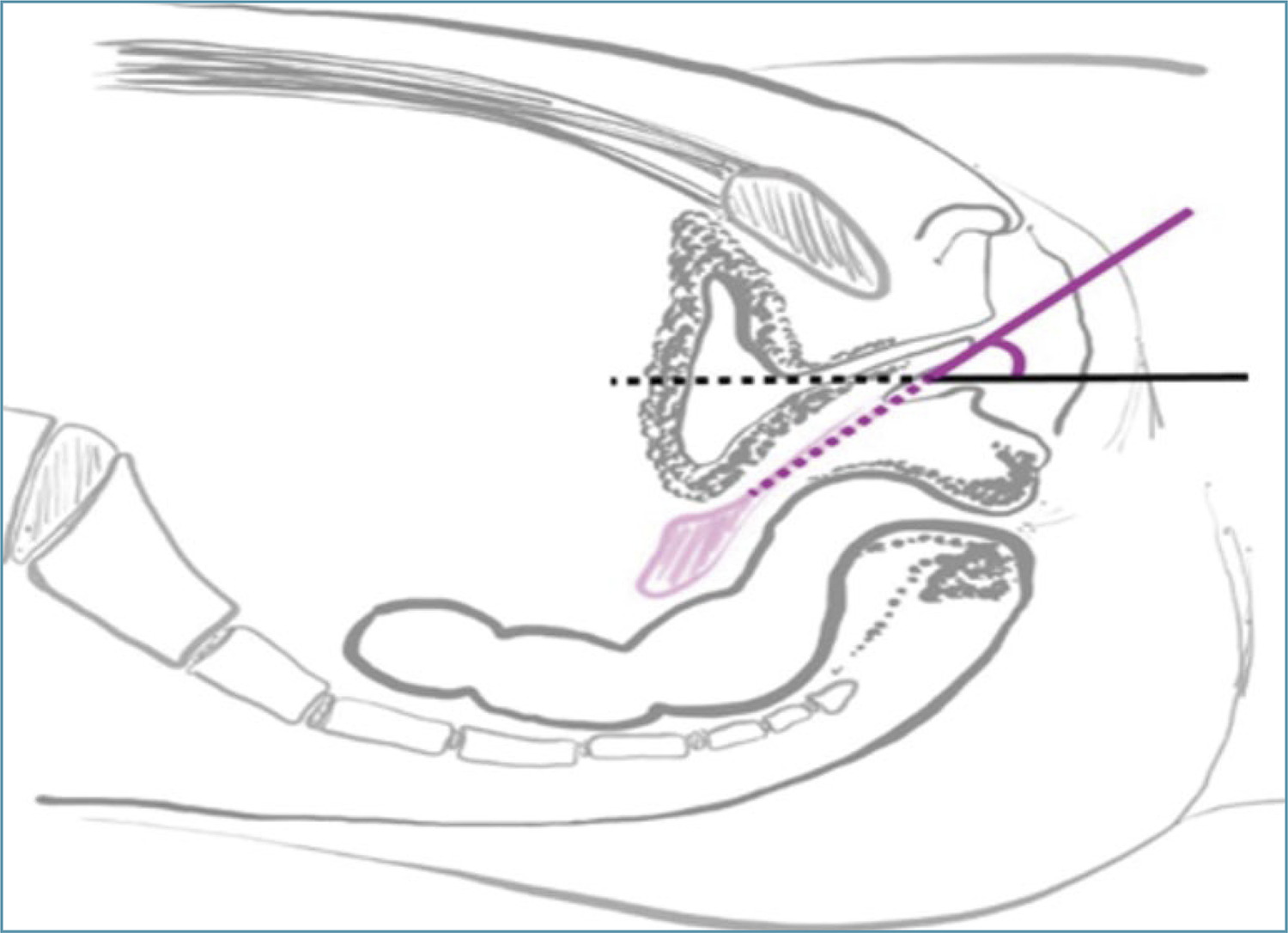
-
Artigo Original30/04/2025
Hysterectomy rates per resident in final year of training in teaching hospitals: an ecologic study
Revista Brasileira de Ginecologia e Obstetrícia. 2025;47:e-rbgo24
Resumo
Artigo OriginalHysterectomy rates per resident in final year of training in teaching hospitals: an ecologic study
Revista Brasileira de Ginecologia e Obstetrícia. 2025;47:e-rbgo24
Visualizações222Abstract
Objective:
Analyze the hysterectomy rates per resident in graduation year in teaching hospitals in the state of São Paulo (Brazil).
Methods:
We selected teaching hospitals in the state of São Paulo and gathered information from two public databases to estimate the hysterectomy rates per resident in their final year of training between 2009 and 2019.
Results:
Between 2009 and 2019, there was a 37.5% increase in the number of residents in their final year of training, a 4.31% increase in the number of hysterectomies, and a drop in the hysterectomy rates per resident of 24.1%. The reduction of the rate of hysterectomy per resident was more pronounced for vaginal route (46.4%) followed by abdominal route (23.3%). The ratio of laparoscopic hysterectomy per resident increased 264% during the period, however, this route was used in only 7% of the surgeries in 2019.
Conclusions:
The hysterectomy rates per resident in their final year of training showed a notable reduction. This trend, particularly pronounced in vaginal and abdominal routes, signals a shift towards minimally invasive techniques.
Palavras-chave: Clinical competenceEducation, medicalHospitals, teachingHysterectomylearning curveMedical staff, hospitalPhysiciansStudents, medicalSurgical procedures, operativeVer mais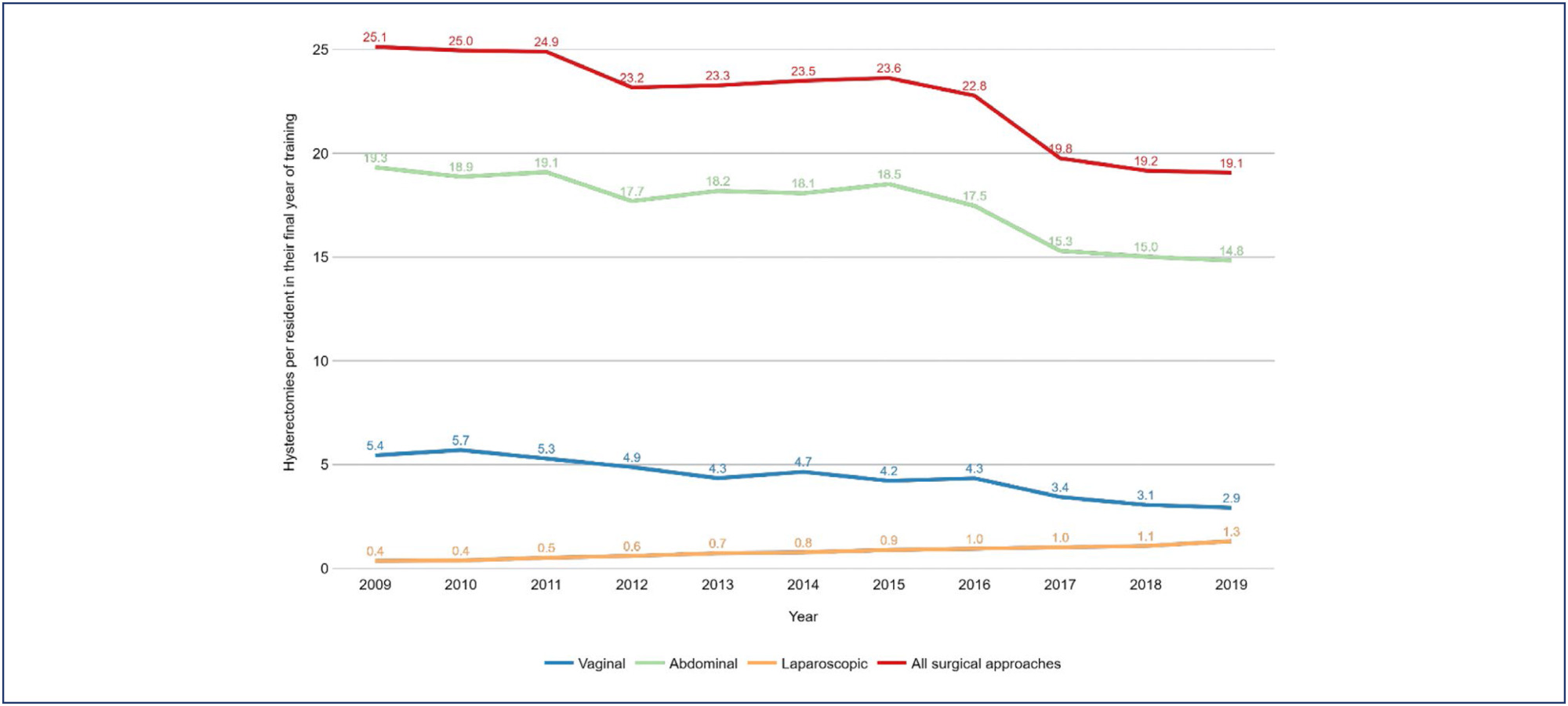
-
Artigo Original30/04/2025
Prevalence of antiphospholipid syndrome among women with recurrent pregnancy loss: a cohort study
Revista Brasileira de Ginecologia e Obstetrícia. 2025;47:e-rbgo23
Resumo
Artigo OriginalPrevalence of antiphospholipid syndrome among women with recurrent pregnancy loss: a cohort study
Revista Brasileira de Ginecologia e Obstetrícia. 2025;47:e-rbgo23
Visualizações226Abstract
Objective:
This study aimed to evaluate the prevalence of antiphospholipid syndrome (APS) among women experiencing recurrent pregnancy loss (RPL).
Methods:
A cross-sectional was conducted, reviewing the medical records of 134 women with a history of two or more miscarriages, treated between January 2014 and May 2024 at a tertiary university center in Belo Horizonte, Brazil. APS screening was performed by assessing anticardiolipin (IgG and IgM), lupus anticoagulant, and anti-β2-glycoprotein-1 (IgG and IgM) antibodies, based on Sapporo criteria. All tests were performed during non-pregnant periods and at least 12 weeks after the last miscarriage.
Results:
The study included 134 women with a mean age of 33.8 ± 5.7 years. The number of prior miscarriages ranged from 2 to 11 per couple. Among the patients who presented the lupus anticoagulant, only two (1.49%) tested positive in two samples, as per revised Sapporo criteria. Considering IgG and IgM anticardiolipin antibodies, four patients (2.98%) tested positive in two samples according to old Sapporo criteria, with one patient having a positive IgG test in two samples, two having positive IgM in two samples and a single patient having both positive tests. None of the 56 patients tested positive for anti-β2-glycoprotein-1 antibodies in two samples.
Conclusion:
The prevalence of antiphospholipid antibodies, in line with revised Sapporo criteria, is low among Brazilian women with recurrent pregnancy loss, consistent with recent studies in literature. Ensuring the appropriateness of diagnostic criteria is crucial to avoid unnecessary treatment with platelet anticoagulants and heparin in this population.
Palavras-chave: Abortion, habitualAbortion, spontaneousAntibodiesAnticardiolipinAntiphospholipid syndromePrevalenceThrombophiliaVer mais -
Artigo Original30/04/2025
An assessment of total antioxidant and oxidant parameters and their correlation with embryo quality in in-vitro fertilization patients
Revista Brasileira de Ginecologia e Obstetrícia. 2025;47:e-rbgo22
Resumo
Artigo OriginalAn assessment of total antioxidant and oxidant parameters and their correlation with embryo quality in in-vitro fertilization patients
Revista Brasileira de Ginecologia e Obstetrícia. 2025;47:e-rbgo22
Visualizações205Abstract
Objective:
In vitro, fertilization is the primary treatment method for infertility. Follicular fluid analysis is an approach used to optimize the results of assisted reproductive techniques. Oxidative stress represents the imbalance between the production of reactive oxygen species and their detoxification. Total Antioxidant and Oxidant Status, and Oxidative Stress Index levels are the main oxidative stress markers. This study investigated the effects of oxidative stress markers on infertility etiology, embryo quality, and success of In vitro fertilization.
Methods:
Before enrolling in the ICSI-ET cycle, participants had their FSH and LH levels assessed on the second day of the cycle. The ovarian degrees of the participants were evaluated by transvaginal ultrasonography. Participants underwent controlled ovarian stimulation using the GnRH antagonist protocol. TV-USG and serial E2 measurements were performed at appropriate intervals to follow follicular development. Follicle sizes, quantity, and endometrial thickness were recorded. Total Antioxidant and Oxidant Status, and Oxidative analyses were conducted using Rel Assay Diagnostics Assay Kits.
Results:
The average number of total oocytes in the participants was 10.25±6.66, and the average of mature M2 stage oocytes was 6.71±3.72. The average number of fertilized oocytes was 4.65±2.81. Fertilization rates were calculated as approximately 54.75±25.58%. A statistically significant positive correlation was found between embryo quality and serum Total Antioxidant Status levels (p=0.004). Similarly, a significant positive correlation was observed between embryo quality and follicular Total Antioxidant Status values (r = 0.42, p = 0.01).
Conclusion:
This study concluded that oxidative stress markers affect certain stages of the IVF treatment process.
Palavras-chave: AntioxidantsFertilization in vitroFollicular fluidInfertilityOocytesOxidantsOxidative stressVer mais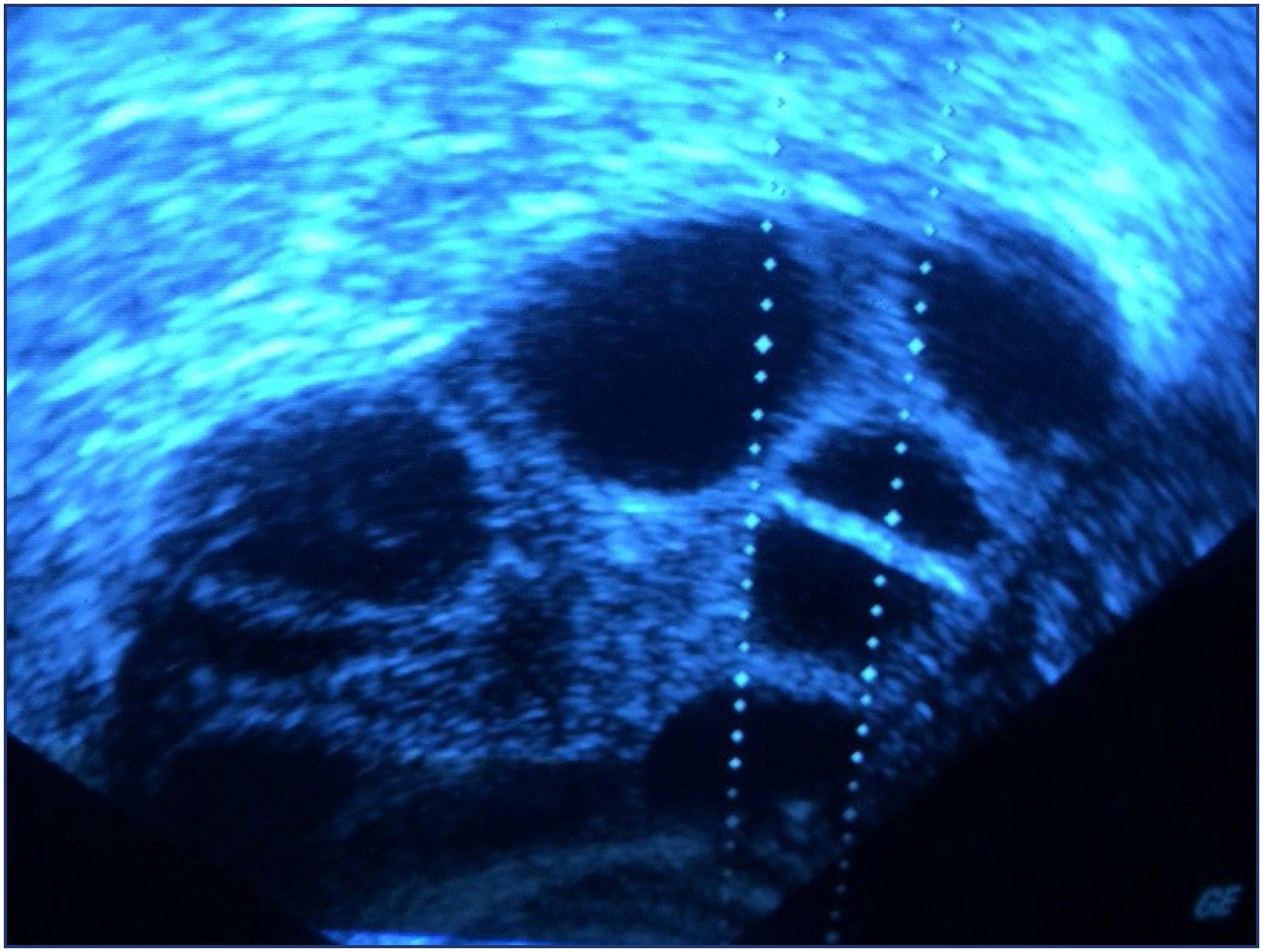
-
Artigo Original04/09/2008
Recanalização tubária: análise dos resultados de 30 anos de tratamento
Revista Brasileira de Ginecologia e Obstetrícia. 2008;30(6):294-299
Resumo
Artigo OriginalRecanalização tubária: análise dos resultados de 30 anos de tratamento
Revista Brasileira de Ginecologia e Obstetrícia. 2008;30(6):294-299
DOI 10.1590/S0100-72032008000600005
Visualizações67OBJETIVO: verificar a freqüência de gestação intra-uterina em pacientes que foram submetidas à recanalização tubária no Hospital Regional da Asa Sul nos últimos 30 anos e avaliar o índice de gestação ectópica destes procedimentos e a influência da idade e do tempo decorrido entre a laqueadura e a recanalização no sucesso terapêutico. MÉTODOS: foram analisados 71 prontuários, tendo sido excluídos os que apresentavam outras alterações que pudessem influenciar no prognóstico de fertilidade do casal e os casos em que não foi possível a cirurgia de recanalização. As variáveis coletadas foram: a ocorrência de gestação intra-uterina, chegando esta a termo ou a abortamento; a ocorrência de gestação ectópica após a cirurgia; a não-concepção após a reversão; a idade das mulheres na data da recanalização e o tempo decorrido entre a laqueadura e a sua reversão. RESULTADOS: verificaram-se um índice de gravidez de 67,6%, sendo 73,2% para as recanalizações bilaterais e 46,6% para as unilaterais, e um percentual de gravidez ectópica de 5,6%. Nas faixas etárias entre 20 e 24 anos, foi observado 33% de gravidez; entre 25 e 29, 60%; entre 30 e 34, 69,2%; entre 35 e 39, 65%, e entre 40 e 44, 42,9%. A casuística foi pequena para análise dos grupos de 20 e 24 e 40 e 44 anos. O intervalo de tempo entre a laqueadura e a recanalização (ITLR) variou de um a 18 anos. O intervalo de tempo entre a ITLR foi dividido em três grupos que apresentaram as taxas de gravidez: de um a seis anos, 59%; de sete a 12 anos, 66,6%; de 13 a 18 anos, 57%. CONCLUSÕES: o índice de gestação foi de 67,6%, sendo 5,6%, ectópicas. Comparando as faixas etárias, não houve influência significativa da idade no sucesso terapêutico entre 25 e 39 anos. Verificou-se que não houve influência do tempo de esterilidade sobre os resultados da reversão.
Palavras-chave: Anastomose cirúrgicaGravidez EctópicaMicrocirurgiaResultado de tratamentoReversão da esterilizaççãoTaxa de gravidezVer mais -
Artigo Original05/06/2008
Sling de aponeurose e com faixa sintética sem tensão para o tratamento cirúrgico da incontinência urinária de esforço feminina
Revista Brasileira de Ginecologia e Obstetrícia. 2008;30(3):127-134
Resumo
Artigo OriginalSling de aponeurose e com faixa sintética sem tensão para o tratamento cirúrgico da incontinência urinária de esforço feminina
Revista Brasileira de Ginecologia e Obstetrícia. 2008;30(3):127-134
DOI 10.1590/S0100-72032008000300005
Visualizações57OBJETIVO: comparar as cirurgias de sling de aponeurose e TVT (do inglês tension-free vaginal tape) para correção da incontinência urinária de esforço (IUE) quanto às taxas de cura subjetiva e objetiva, à mobilidade do colo vesical ao ultra-som, à variação do teste do absorvente, às alterações urodinâmicas e à incidência de complicações. MÉTODOS: foram selecionadas 80 pacientes com IUE. Destas, 61 foram operadas pela técnica de TVT e 19 por sling de aponeurose do reto abdominal. As médias de idade, índice de massa corpórea e paridade foram 50,1 anos, 29,7 kg/m² e 4,5 partos (mediana=3) para as pacientes com sling de aponeurose e de 51,7 anos, 28,1 kg/m² e 4,1 partos (mediana=3) para aquelas com TVT. Todas se submeteram a anamnese, exame físico, ultra-sonografia do colo vesical, teste do absorvente e estudo urodinâmico no pré-operatório e após, pelo menos, seis meses depois da cirurgia. Após 15 ou 19 meses e depois de cerca de quatro a cinco anos, foram novamente entrevistadas quanto aos resultados da cirurgia. RESULTADOS: quanto à avaliação subjetiva, após seis meses, julgaram-se curadas 96,7% das mulheres com TVT e 89,5% das com sling. Porém, após 15 a 19 meses, o Grupo TVT manteve a mesma taxa de cura subjetiva, enquanto que no Grupo Sling houve redução para 77,8%. Houve diminuição significativa da mobilidade do colo vesical, similar em ambos os grupos, e melhora no teste do absorvente. No final do estudo urodinâmico, foram classificadas como cura objetiva 93,4% das mulheres do Grupo TVT e 78,9% daquelas do Grupo Sling. O tempo médio de sondagem vesical foi maior no Grupo Sling. Observou-se retenção urinária em 42,1% dos casos de sling e em 9,8% de TVT. As taxas de cura tardia foram 90% para TVT e 55,6% para sling. CONCLUSÕES: a cirurgia de TVT propiciou melhor taxa de cura subjetiva após 15 ou 19 meses, porém, a taxa de cura objetiva foi igual em ambas as técnicas neste tempo. Entre as complicações detectadas, a retenção urinária no pós-operatório foi superior no Grupo Sling.
Palavras-chave: Incontinência urinária por estresseProcedimentos cirúrgicos minimamente invasivosProcedimentos cirúrgicos urológicosSlings suburetraisVer mais -
Editorial01/08/2017
Barreiras à implementação e consolidação de um programa de planejamento familiar que atenda às necessidades brasileiras
Revista Brasileira de Ginecologia e Obstetrícia. 2017;39(8):373-375
Resumo
EditorialBarreiras à implementação e consolidação de um programa de planejamento familiar que atenda às necessidades brasileiras
Revista Brasileira de Ginecologia e Obstetrícia. 2017;39(8):373-375
-
Artigo Original01/07/2001
Vaginose Bacteriana em Mulheres com Infertilidade e em Menopausadas
Revista Brasileira de Ginecologia e Obstetrícia. 2001;23(10):641-646
Resumo
Artigo OriginalVaginose Bacteriana em Mulheres com Infertilidade e em Menopausadas
Revista Brasileira de Ginecologia e Obstetrícia. 2001;23(10):641-646
DOI 10.1590/S0100-72032001001000005
Visualizações53Ver maisObjetivo: analisar a prevalência de vaginose bacteriana (VB) em mulheres inférteis e em menopausadas e os métodos mais comumente usados na prática clínica para o seu diagnóstico. Métodos: foram avaliadas retrospectivamente 104 pacientes na menopausa e 86 inférteis. A presença de corrimento vaginal característico, pH vaginal >4,5, teste das aminas (whiff test) positivo e achado de vaginose bacteriana à coloração da secreção pelo Gram foram considerados positivos. Foi estabelecido diagnóstico de VB quando 3 dos 4 critérios acima fossem satisfeitos. Resultados: analisando os métodos diagnósticos separadamente observamos, entre as menopausadas, 29 pacientes com corrimento vaginal característico (28,1%), 10 (9,6%) com whiff test positivo, 68 (65,4%) com pH vaginal >4,5 e 34 (32,7%) com teste do Gram positivo. Nas mulheres inférteis os resultados foram 20 (23,2%), 13 (15,1%), 61 (70,9%) e 26 (30,2%), respectivamente. Ao analisarmos todos os critérios em conjunto, em 14 pacientes na menopausa (13,5%) e em 15 inférteis (17,4%) foi diagnosticada VB. Conclusão: a prevalência de VB foi similar nos 2 grupos de pacientes. Além disso, todos os métodos diagnósticos devem ser utilizados a fim de não se sub ou super-diagnosticar essa patologia.
-
Artigo Original08/09/2003
Comparação entre três escores embrionários como fator prognóstico do sucesso em fertilização in vitro
Revista Brasileira de Ginecologia e Obstetrícia. 2003;25(3):177-183
Resumo
Artigo OriginalComparação entre três escores embrionários como fator prognóstico do sucesso em fertilização in vitro
Revista Brasileira de Ginecologia e Obstetrícia. 2003;25(3):177-183
DOI 10.1590/S0100-72032003000300006
Visualizações62Ver maisOBJETIVO: avaliar três sistemas de escore embrionário para embriões de 3º dia e correlacioná-los com resultados positivos da técnica de fertilização in vitro. MÉTODO: estudo retrospectivo desenvolvido pelo programa de fertilização in vitro do Hospital das Clínicas da Faculdade de Medicina de Ribeirão Preto – USP. Foram incluídas 137 pacientes submetidas a fertilização in vitro e transferência de 439 embriões. Os principais resultados avaliados foram taxa de gravidez e taxa de implantação. RESULTADOS: nos três métodos observou-se diferença significativa no escore embrionário entre o grupo de grávidas (n=53) e não grávidas (n=84) (p<0,0001). No escore 1, avaliando-se apenas o número de células, observou-se maior taxa de gravidez (70%) e taxa de implantação (42%) nas transferências de embriões com média dos blastômeros acima de 8. O escore 2, baseado num escore total de quatro pontos (clivagem, número de blastômeros, fragmentação e simetria), mostrou aumento nas taxas de gravidez (52,8%) e implantação (31%) nos escores acima de 2. No escore 3, baseado no número de células e no grau morfológico, também as taxas de gravidez e de implantação elevaram-se de acordo com o aumento do escore médio dos embriões transferidos. CONCLUSÃO: Os três sistemas de escore avaliados em embriões de 3º dia, correlacionaram-se positivamente com taxa de gravidez e taxa de implantação.
-
Artigo Original04/08/2004
Sinais ultra-sonográficos em fetos portadores de toxoplasmose congênita
Revista Brasileira de Ginecologia e Obstetrícia. 2004;26(5):377-382
Resumo
Artigo OriginalSinais ultra-sonográficos em fetos portadores de toxoplasmose congênita
Revista Brasileira de Ginecologia e Obstetrícia. 2004;26(5):377-382
DOI 10.1590/S0100-72032004000500006
Visualizações69Ver maisOBJETIVO: descrever as alterações ultra-sonográficas em fetos com toxoplasmose congênita, correlacionando-as com o prognóstico neonatal. MÉTODOS: entre junho de 1997 e maio de 2003 foram examinadas 150 gestantes com suspeita de toxoplasmose. A infecção aguda foi confirmada em 72 (48%) gestantes e a toxoplasmose congênita foi diagnosticada em 12 (16%) fetos. O diagnóstico pré-natal foi realizado pela reação em cadeia da polimerase no líquido amniótico. Todas as pacientes receberam terapia antiparasitária. O acompanhamento ultra-sonográfico foi quinzenal e todos os recém-nascidos foram acompanhados no primeiro ano de vida. RESULTADOS: as alterações ultra-sonográficas foram observadas em oito fetos. Todos apresentavam dilatação ventricular bilateral, associada a calcificações periventriculares em cinco casos. Outras alterações como calcificação hepática, hepatomegalia, poliidrâmnio e derrame pericárdico foram menos freqüentes. Dentre esses fetos, quatro foram neomortos e três apresentaram seqüelas (coriorretinite e retardo neuropsicomotor). Os quatro fetos com ultra-sonografia normal evoluíram satisfatoriamente. CONCLUSÃO: observou-se elevada incidência de alterações ultra-sonográficas nos fetos com toxoplasmose congênita, principalmente cerebrais. Outras alterações como hepatomegalia e derrame pericárdio são menos freqüentes e traduzem infecção sistêmica. O prognóstico dos fetos parece correlacionar-se com a presença de lesões ultra-sonográficas, uma vez que nesse grupo de fetos observou-se alta mortalidade e entre os sobreviventes a incidência de seqüelas foi importante. Os fetos sem alterações ultra-sonográficas evoluíram de forma favorável, sem seqüelas de desenvolvimento. Esses resultados destacam a importância da ultra-sonografia no acompanhamento desses fetos, a fim de se estabelecer um prognóstico e permitir a elaboração de conduta pós-natal adequada.
-
Artigo Original04/08/2004
Predição da restrição do crescimento fetal pela medida da altura uterina
Revista Brasileira de Ginecologia e Obstetrícia. 2004;26(5):383-389
Resumo
Artigo OriginalPredição da restrição do crescimento fetal pela medida da altura uterina
Revista Brasileira de Ginecologia e Obstetrícia. 2004;26(5):383-389
DOI 10.1590/S0100-72032004000500007
Visualizações72OBJETIVO: avaliar o emprego da medida da altura uterina para o diagnóstico da restrição do crescimento fetal (RCF), empregando como padrão curvas conhecidas de evolução da altura uterina do próprio serviço. MÉTODOS: entre julho de 2000 e fevereiro de 2003, 238 gestantes de alto risco foram submetidas a medidas de altura uterina, da 20ª à 42ª semana de gestação. Todas possuíam idade gestacional confirmada por ultra-sonografia precoce. Cinqüenta (21,0%) gestantes tiveram recém-nascidos pequenos para a idade gestacional. O mesmo observador realizou 1617 medidas de altura uterina, com fita métrica, da borda superior da sínfise púbica ao fundo uterino. A confirmação do diagnóstico de RCF foi dada após o nascimento pela curva de Ramos. Para a análise estatística, as gestantes foram comparadas segundo o peso dos recém-nascidos, por meio do teste exato de Fisher ou teste não paramétrico de Kruskal-Wallis, quando aplicável. Foram calculados: sensibilidade (S), especificidade (E), valor preditivo positivo (VPP) e negativo (VPN) para o diagnóstico de RCF. Para a análise dos valores contínuos foi utilizado o teste para duas proporções com aproximação normal. RESULTADOS: para a ocorrência de RCF, considerando-se uma medida de altura uterina abaixo do percentil 10 para a idade gestacional, S foi de 78%, E de 77,1%, VPP de 47,6% e VPN de 92,9%. Utilizando como limite o percentil 5, foram obtidos S = 64%, E = 89,9%, VPP = 62,7% e VPN = 90,4%, para o diagnóstico da RCF. CONCLUSÃO: medida de altura uterina abaixo do percentil 10 para a idade gestacional, pela curva local, mostra-se como bom teste para o rastreamento da RCF.
Palavras-chave: Desenvolvimento fetalDiagnóstico pré-natalGravidez de alto riscoRestrição do crescimento fetalVer mais -
Artigo Original25/03/2014
Achados histeroscópicos na cavidade endometrial após ablação endometrial
Revista Brasileira de Ginecologia e Obstetrícia. 2014;36(4):170-175
Resumo
Artigo OriginalAchados histeroscópicos na cavidade endometrial após ablação endometrial
Revista Brasileira de Ginecologia e Obstetrícia. 2014;36(4):170-175
DOI 10.1590/S0100-720320140050.0001
Visualizações55Ver maisOBJETIVO:
Verificar o aspecto da cavidade uterina após a ablação endometrial histeroscópica, a prevalência de sinéquias após o procedimento e, com isso, avaliar a importância da histeroscopia realizada no pós-operatório dessas pacientes.
MÉTODOS:
Foram avaliados, retrospectivamente, os laudos dos exames de 153 pacientes que haviam sido submetidas à histeroscopia ambulatorial após ablação do endométrio devido a sangramento uterino anormal de causa benigna, no período entre janeiro de 2006 e julho de 2011. As pacientes foram divididas em dois grupos: HIST≤60 (n=90), com pacientes submetidas ao exame no período de 40 a 60 dias após o procedimento, e grupo HIST>60 (n=63), das que foram examinadas entre 61 dias e 12 meses.
RESULTADOS:
No grupo HIST≤60, 30% das pacientes apresentavam algum grau de sinéquia; aderências grau I foram descritas em 4,4%; grau II em 6,7%; grau IIa em 4,4%; grau III em 7,8%; e 2,2% apresentavam grau IV. No HIST>60, sinéquias foram descritas em 53,9% dos casos, 3,2% tinham sinéquias grau I; 11,1%, grau II; 7,9%, grau IIa; 15,9%, grau III; e 4,8%, grau IV. Hematometra foi descrito em 2,2% dos casos do HIST≤60 e em 6,3% no HIST>60.
CONCLUSÕES:
A cavidade uterina de pacientes submetidas à histeroscopia ambulatorial até 60 dias após a ablação endometrial mostrou menor número de sinéquias quando comparada com as cavidades uterinas de pacientes que foram submetidas ao exame após 60 dias. Acompanhamento em longo prazo é necessário para avaliar plenamente o impacto da histeroscopia ambulatorial após a ablação endometrial.
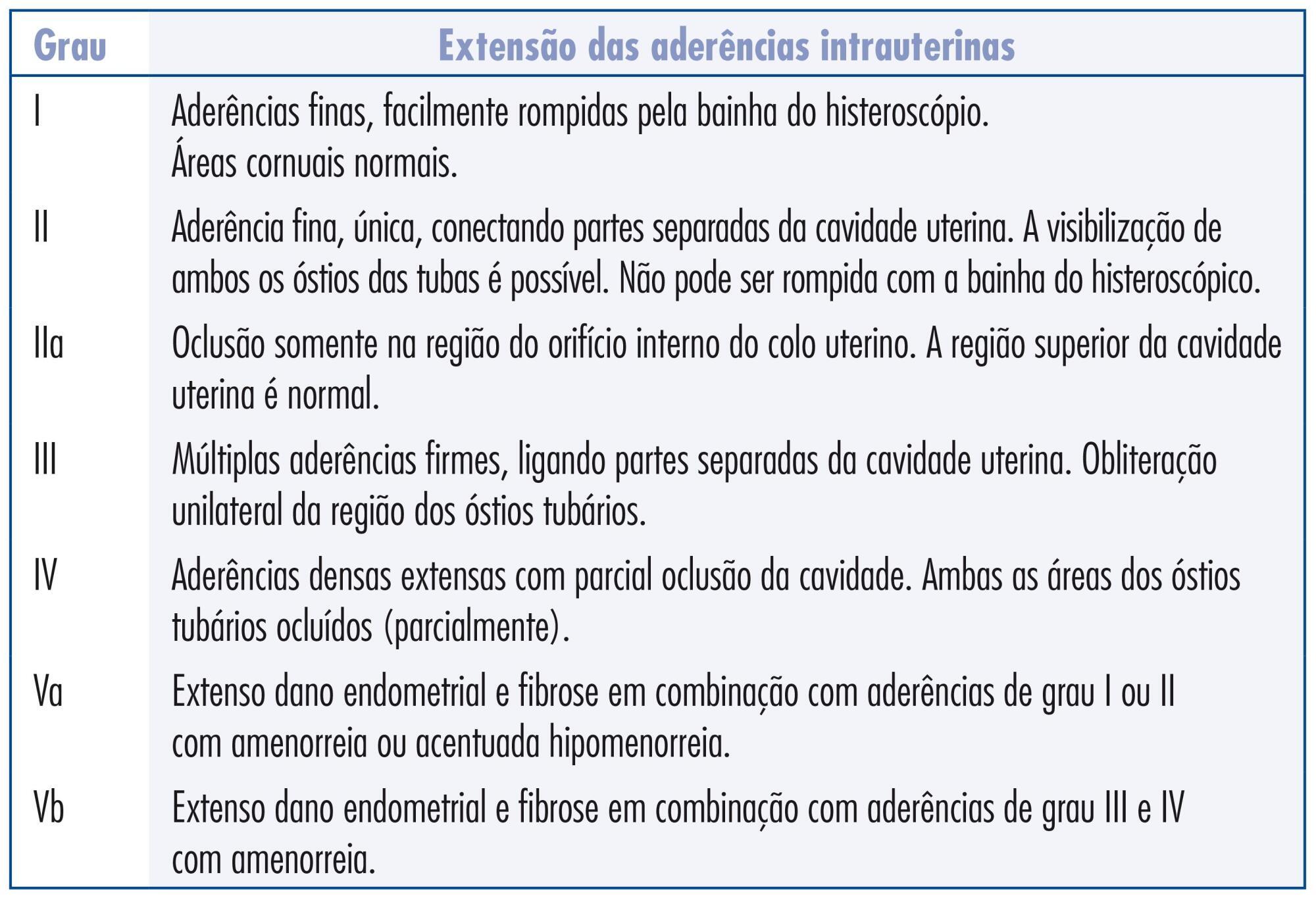
Busca
Pesquisar em:
Nuvem de Tags
Gravidez (167)Fatores de risco (89)Menopausa (79)Pré-eclâmpsia (66)Endometriose (65)Mama (59)Infertilidade (58)Obesidade (57)Complicações na gravidez (56)Diagnóstico pré-natal (54)Gestação (54)Qualidade de vida (53)Saúde da mulher (51)Cesárea (50)Complicações da gravidez (50)Neoplasias da mama (49)Fertilização in vitro (48)Cuidado pré-natal (47)Mortalidade materna (43)Ultra-sonografia (43)


